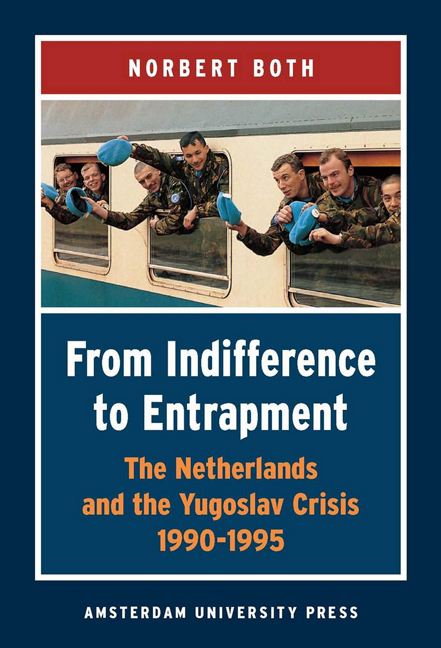Book contents
- Frontmatter
- Dedication
- Contents
- Preface
- Abbreviations
- Chronology
- Introduction
- 1 The Netherlands and its Foreign Policy System
- 2 An Emerging Challenge, July 1990 - June 1991
- 3 From ‘Even-Handedness’ to ‘Selectiveness’, July -December 1991
- 4 Moral and Political Entrapment: The Netherlands and International Peace Plans for Bosnia, 1992-1994
- 5 Military Entrapment: The Commitment to Srebrenica
- Conclusion
- Bibliography
- Index of Names
3 - From ‘Even-Handedness’ to ‘Selectiveness’, July -December 1991
Published online by Cambridge University Press: 14 January 2021
- Frontmatter
- Dedication
- Contents
- Preface
- Abbreviations
- Chronology
- Introduction
- 1 The Netherlands and its Foreign Policy System
- 2 An Emerging Challenge, July 1990 - June 1991
- 3 From ‘Even-Handedness’ to ‘Selectiveness’, July -December 1991
- 4 Moral and Political Entrapment: The Netherlands and International Peace Plans for Bosnia, 1992-1994
- 5 Military Entrapment: The Commitment to Srebrenica
- Conclusion
- Bibliography
- Index of Names
Summary
The Yugoslav crisis was escalating into armed conflict. TV images of skirmishes in Slovenia in late June 1991 brought home to European and American families the incredible message that war had returned to Europe. In Slovenia hostilities ended quickly, due to the combination of an effective defence on the part of the Slovenes and the absence of a Serb minority question. Croatia was not so lucky. Fierce fighting erupted there, which lasted until the end of the year. By the end of 1991, the combined Serb/Yugoslav forces controlled large swaths of territory in the Croatian border areas. The vicious siege of Vukovar, which fell to Serb units in November 1991, and in particular the attacks by Montenegrin units of the Yugoslav People's Army on the tourist town of Dubrovnik, aroused Western public opinion. Innocent people had been murdered in cold blood on both sides, but the mass murder by Serb forces of Croat patients from the hospital in Vukovar counted as a horrendous crime against humanity.
As holder of the EC Presidency, the Netherlands was in a position of responsibility and influence at an important moment in European history. This position of prominence in the EC might have meant little, had it not been for the fact that the EC itself continued to be in the driver's seat of international Yugoslavia-diplomacy, given the absence of the United States from the scene. The responsibilities associated with the EC Presidency forced Dutch policy makers to operate with more maturity than they had done before and would do later. Moreover, as the stakes began to rise, the Yugoslav crisis became a priority issue for Foreign Minister Hans van den Broek, who according to one of his Cabinet colleagues kept the Yugoslavia-issue ‘rather close to his chest’.
Dutch policy during the second half of 1991 constituted a broad movement from ‘even-handedness’ to ‘selectiveness’. The initial approach was ‘even-handed’ to all the Yugoslav parties. Increasingly, ‘even-handedness’ was seen as an ineffective way to contain the strongest and most aggressive party to the conflict, Serbia. As a result, this approach gave way to one that was ‘selective’ and directed primarily against Serbia and the Yugoslav army. This is not to suggest that the development from even-handedness to selectiveness was a smooth one.
- Type
- Chapter
- Information
- From Indifference to EntrapmentThe Netherlands and the Yugoslav Crisis, 1990–1995, pp. 101 - 142Publisher: Amsterdam University PressPrint publication year: 2012



